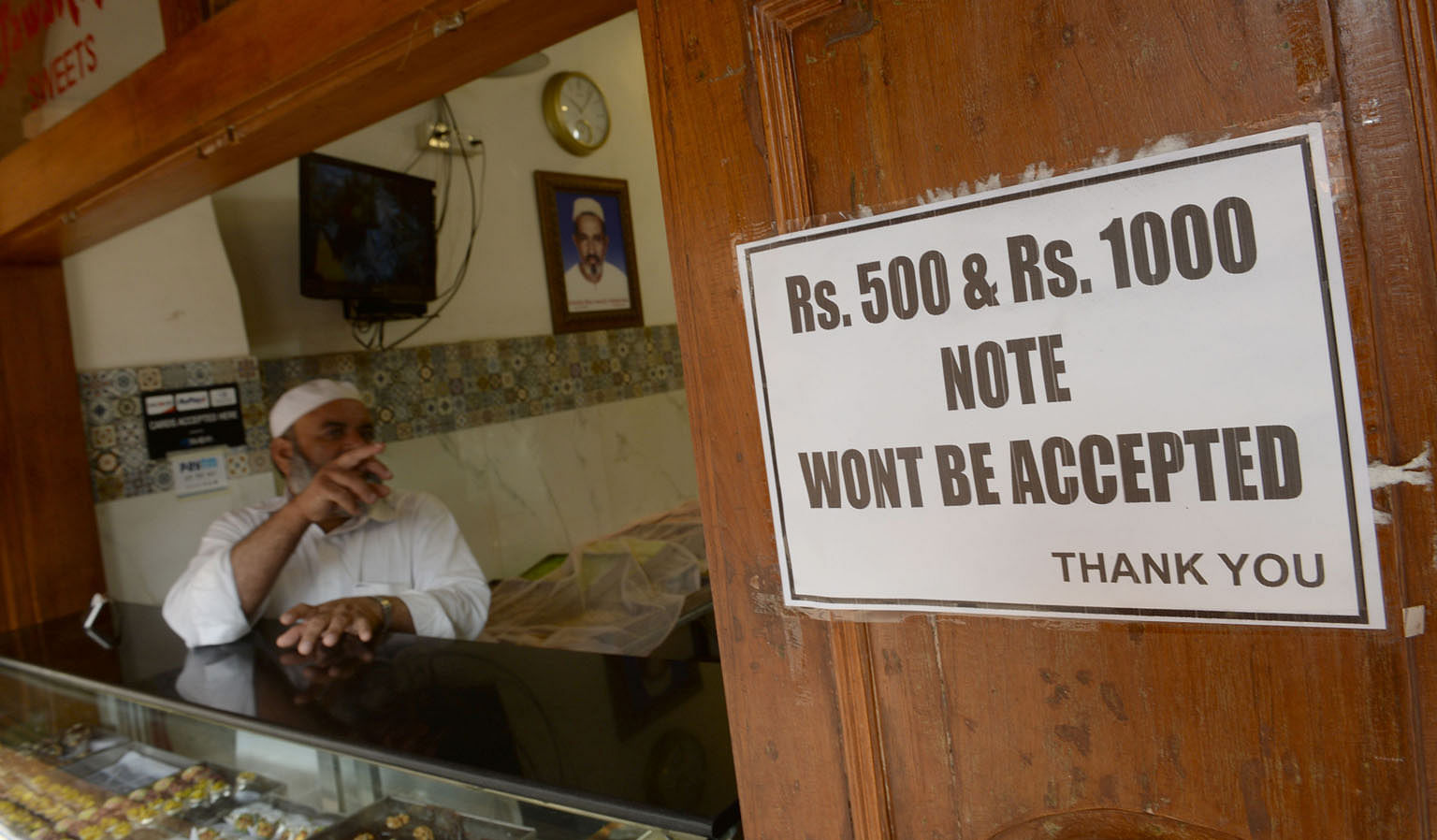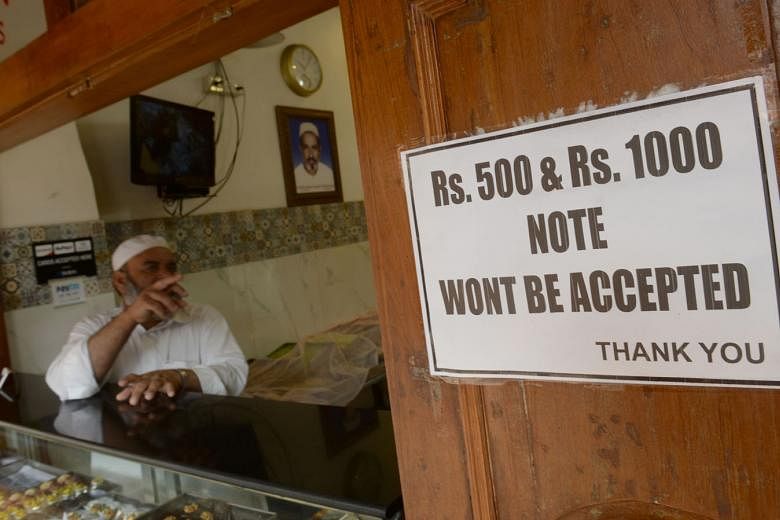India's economy appears to have been jolted out of its steady growth path by the demonetisation of 500- and 1,000-rupee notes (equivalent to S$10 and S$20).
Indian Prime Minister Narendra Modi's government made a sudden move on Nov 8 to withdraw the legal tender status of these high-value currency notes. The move set off popular protests, has led opposition parties to interrupt national parliamentary proceedings, and caused ratings agencies to issue dire predictions of a precipitous fall in growth rate.
India's ever-vigilant media and opposition political parties have seized on this move to give wide publicity to public hardship caused by demonetisation.
Families hoarding these notes find themselves out of viable cash to buy things; corner shops run out of change; and national supply chains in India's cash-dominated economy whose wholesalers, grain dealers and farmers deal mostly in high-currency notes have fractured.
Meanwhile, political parties opposed to Mr Modi's Hindu nationalist Bharatiya Janata Party have sensed a political opportunity, in view of important regional elections just round the corner.

Some respected economists - like former US Treasury secretary Larry Summers, India's former prime minister Manmohan Singh, and Nobel laureate Amartya Sen - have called demonetisation a bad move.
Is this a strategic misstep on the part of Mr Modi, both for the electoral prospects of the ruling National Democratic Alliance, of which his party is the core constituent, and for India's economy as a whole?
To answer that question requires us to take a step back to look at Mr Modi's multiple objectives in making these high-value currency notes no longer legal tender.
First , the government presented the measure as part of its strategy to curb "black money" - unaccounted-for cash (estimated by the World Bank to be equivalent to a quarter of India's gross domestic product) that fuels mostly illegal transactions, evades official scrutiny and dodges taxation.
The practice is rampant in India's real-estate deals, financing of electoral campaigns, films, bribery and funding of terrorist and other criminal activities. These cash transactions are done through high-denomination currency notes (the 500- and 1,000-rupee notes account for 86 per cent of India's total cash in circulation).
The sudden act of demonetisation is meant to flush out these concealed monies. It should be noted here that the government move is by no means meant to confiscate the money.
Instead, measures have been laid out to facilitate the transformation of these monies by depositing all legal cash into bank accounts, with a time limit that extends up to the end of the year.
In addition, the income-tax law has been modified to provide an incentive for owners of unaccounted-for money to legalise their reserves, by paying a penalty of 50 per cent for legalising unaccounted-for money.
Demonetisation is thus part of a general move to enhance financial governance by bringing the parallel economies of India under government scrutiny, put a brake on corruption, enhance transparency in transactions and bring in tax revenues - much needed for a country which needs massive investments in infrastructure building.
The suddenness of the move has taken both the owners of black money as well as ordinary people by surprise. Paper currencies function on the basis of their credibility as means of exchange. The moment currency notes lose their value as legal tender, all transactions based on them come to a standstill.
The suddenness of demonetisa- tion has not permitted banks, traders and ATMs to equip them- selves with smaller-currency notes and new 500-rupee and 2,000- rupee notes that have been issued.
The secrecy and abruptness of the measure are understandable. A gradual process (or leakage of the information) would have seen the swift transformation of black money into real estate, property, stocks, gold, foreign currency and other methods of evasion.
It is remarkable that a month after the move, India's economy as a whole appears to have coped with the transition to new currency.
Financial institutions estimate that the rate of growth will slow by 0.5 to 2 percentage points this quarter and the next, before returning to the normal trend.
Many commentators point to long-term gains from demonetisation by way of a switch to digitalisation, extension of banking coverage, increase in integrity and transparency of the Indian economy.
This will spur foreign direct investment, enhance ease of doing business and increase investor confidence, which will, in turn, increase the productive capacity of the economy.
More money deposited in banks would mean lower interest rates. That, combined with more tax revenue, could lead to more investment and stimulate growth.
By and large, global economic stakeholders have welcomed demonetisation. The State Department of the United States, which considers demonetisation "important and necessary to curb illicit cash and actions", credits the Modi government for honouring its electoral promise to curb black money.
THE POLITICS OF THE MOVE
But, electoral politics in a vigorous democracy like India revolves around short-term forces. So, how will the move affect politics?
Reassuringly for the Modi government, the efforts by the opposition Congress party to project demonetisation as "organised loot, legalised plunder" appears to have elicited little resonance across the country.
Instead, the reforms appear to have elicited wide popular support from ordinary folks who appreciated the effort to bring the shadow cash economy under control. By merging the shadow economy with the formal economy, demonetisation will spur economic activity into a virtuous circle.
To be sure, a one-off demonetisation effort cannot be a long-term structural solution to enhance financial governance. Black-marketers do not keep their entire hoard in cash. It is estimated that only a maximum of 15 per cent of the untaxed wealth is retained in higher-denomination currency notes.
The Modi government has taken the political risk of sending out a powerful signal. For Mr Modi personally, this is both a challenge and an opportunity.
By mobilising public opinion to support the move to tame corruption and India's shadow economy, and instilling respect for integrity in transactions through exemplary sanctions against corruption, his government might catch its second wind as it enters the second half of the mandate it got in 2014, and discover a new political slogan which it needs in the run-up to the next general elections, due in 2018.
- Professor Subrata K. Mitra is director, Institute of South Asian Studies, and visiting research professor, National University of Singapore.

